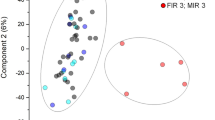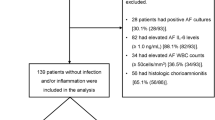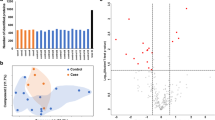Abstract
This review aimed to identify, synthesize, and analyze the findings of studies on proteomic biomarkers for spontaneous preterm birth (PTB). Three electronic databases (Medline, Embase, and Scopus) were searched for studies in any language reporting the use of proteomic biomarkers for PTB published between January 1994 and December 2012. Retrieved citations were screened, and relevant studies were selected for full-text reading, in triplicate. The search yielded 529 citations, 51 were selected for full-text reading and 8 studies were included in the review. A total of 64 dysregulated proteins were reported. Only 14-3-3 protein sigma, annexin A5, protein S100-A8, protein S100-A12, and inter-α-trypsin inhibitor heavy chain H4 were reported in more than 1 study, but results could not be combined due to heterogeneity in type of sample and analytical platform. In conclusion, according to the existing literature, there are no specific proteomic biomarkers capable of accurately predicting PTB.
Similar content being viewed by others
References
Simmons LE, Rubens CE, Darmstadt GL, Gravett MG. Preventing preterm birth and neonatal mortality: exploring the epidemiology, causes, and interventions. Semin Perinatol. 2010;34(6): 408–415.
Bastek JA, Elovitz MA. The role and challenges of biomarkers in spontaneous preterm birth and preeclampsia. Fertil Steril. 2013;99(4): 1117–1123.
Menon R, Torloni MR, Voltolini C, et al. Biomarkers of spontaneous preterm birth: an overview of the literature in the last four decades. Reprod Sci. 2011;18(11): 1046–1070.
Silbergeld EK, Davis DL. Role of biomarkers in identifying and understanding environmentally induced disease. Clin Chem. 1994;40(7 pt 2): 1363–1367.
Kersten B, Wanker EE, Hoheisel JD, Angenendt P. Multiplex approaches in protein microarray technology. Expert Rev Proteomics. 2005;2(4): 499–510.
Dasilva N, Diez P, Matarraz S, et al. Biomarker discovery by novel sensors based on nanoproteomics approaches. Sensors (Basel). 2012;12(2): 2284–2308.
Bea JW, Wright NC, Thompson P, Hu C, Guerra S, Chen Z. Performance evaluation of a multiplex assay for future use in biomarker discovery efforts to predict body composition. Clin Chem Lab Med. 2011;49(5): 817–824.
Wasinger VC, Cordwell SJ, Cerpa- Poljak A, et al. Progress with gene-product mapping of the Mollicutes: Mycoplasma genitalium. Electrophoresis. 1995;16(7): 1090–1094.
Tambor V, Fucikova A, Lenco J, et al. Application of proteomics in biomarker discovery: a primer for the clinician. Physiol Res. 2010;59(4): 471–497.
Anderson NL, Anderson NG. Proteome and proteomics: new technologies, new concepts, and new words. Electrophoresis. 1998;19(11): 1853–1861.
Ong SE, Mann M. Mass spectrometry-based proteomics turns quantitative. Nat Chem Biol. 2005;1(5): 252–262.
Buhimschi CS, Bhandari V, Hamar BD, et al. Proteomic profiling of the amniotic fluid to detect inflammation, infection, and neonatal sepsis. PLoS Med. 2007;4(1): e18.
Buhimschi CS, Dulay AT, Abdel- Razeq S, et al. Fetal inflammatory response in women with proteomic biomarkers characteristic of intra-amniotic inflammation and preterm birth. BJOG. 2009;116(2): 257–267.
Buhimschi IA, Christner R, Buhimschi CS. Proteomic biomarker analysis of amniotic fluid for identification of intra-amniotic inflammation. BJOG. 2005;112(2): 173–181.
Bujold E, Romero R, Kusanovic JP, et al. Proteomic profiling of amniotic fluid in preterm labor using two-dimensional liquid separation and mass spectrometry. J Matern Fetal Neonatal Med. 2008;21(10): 697–713.
Romero R, Kusanovic JP, Gotsch F, et al. Isobaric labeling and tandem mass spectrometry: a novel approach for profiling and quantifying proteins differentially expressed in amniotic fluid in preterm labor with and without intra-amniotic infection/inflammation. J Matern Fetal Neonatal Med. 2010;23(4): 261–280.
Romero R, Espinoza J, Gotsch F, et al. The use of high-dimensional biology (genomics, transcriptomics, proteomics, and metabolomics) to understand the preterm parturition syndrome. BJOG. 2006;113(suppl 3): 118–135.
Whiting PF, Rutjes AW, Westwood ME, et al. QUADAS-2: a revised tool for the quality assessment of diagnostic accuracy studies. Ann Intern Med. 2011;155(8): 529–536.
Pereira L, Reddy AP, Jacob T, et al. Identification of novel protein biomarkers of preterm birth in human cervical-vaginal fluid. J Proteome Res. 2007;6(4): 1269–1276.
Butt RH, Lee MW, Pirshahid SA, Backlund PS, Wood S, Coorssen JR. An initial proteomic analysis of human preterm labor: placental membranes. J Proteome Res. 2006;5(11): 3161–3172.
Stella CL, Bennett MR, Devarajan P, et al. Preterm labor biomarker discovery in serum using 3 proteomic profiling methodologies. Am J Obstet Gynecol. 2009;201(4):387 e1–387 e13.
Shankar R, Johnson MP, Williamson NA, et al. Molecular markers of preterm labor in the choriodecidua. Reprod Sci. 2010;17(3): 297–310.
Cobo T, Palacio M, Navarro- Sastre A, et al. Predictive value of combined amniotic fluid proteomic biomarkers and interleukin-6 in preterm labor with intact membranes. Am J Obstet Gynecol. 2009;200(5):499 e1–499 e6.
Shah SJ, Yu KH, Sangar V, Parry SI, Blair IA. Identification and quantification of preterm birth biomarkers in human cervicovaginal fluid by liquid chromatography/tandem mass spectrometry. J Proteome Res. 2009;8(5): 2407–2417.
Esplin MS, Merrell K, Goldenberg R, et al. Proteomic identification of serum peptides predicting subsequent spontaneous preterm birth. Am J Obstet Gynecol. 2011;204(5):391 e1–391 e8.
Taylor BD, Holzman CB, Fichorova RN, et al. Inflammation biomarkers in vaginal fluid and preterm delivery. Hum Reprod. 2013;28(4): 942–952.
Galazis N, Docheva N, Nicolaides KH, Atiomo W. Proteomic biomarkers of preterm birth risk in women with polycystic ovary syndrome (PCOS): a systematic review and biomarker database integration. PLoS One. 2013;8(1): e53801.
Gravett MG, Novy MJ, Rosenfeld RG, et al. Diagnosis of intra-amniotic infection by proteomic profiling and identification of novel biomarkers. JAMA. 2004;292(4): 462–469.
Han X, Aslanian A, Yates JR 3rd. Mass spectrometry for proteomics. Curr Opin Chem Biol. 2008;12(5): 483–490.
Rabilloud T, Lelong C. Two-dimensional gel electrophoresis in proteomics: a tutorial. J Proteomics. 2011;74(10): 1829–1841.
Thiede B, Koehler CJ, Strozynski M, et al. High resolution quantitative proteomics of HeLa cells protein species using stable isotope labeling with amino acids in cell culture(SILAC), two-dimensional gel electrophoresis(2DE) and nano-liquid chromatograpohy coupled to an LTQ-OrbitrapMass spectrometer. Mol Cell Proteomics. 2013;12(2): 529–538.
Towbin H, Staehelin T, Gordon J. Electrophoretic transfer of proteins from polyacrylamide gels to nitrocellulose sheets: procedure and some applications. Proc Natl Acad Sci U S A. 1979;76(9): 4350–4354.
Linke T, Ross AC, Harrison EH. Proteomic analysis of rat plasma by two-dimensional liquid chromatography and matrix-assisted laser desorption ionization time-of-flight mass spectrometry. J Chromatogr A. 2006;1123(2): 160–169.
Michalski A, Damoc E, Hauschild JP, et al. Mass spectrometry-based proteomics using Q Exactive, a high-performance benchtop quadrupole Orbitrap mass spectrometer. Mol Cell Proteomics. 2011;10(9): M111.011015.
Bantscheff M, Lemeer S, Savitski MM, Kuster B. Quantitative mass spectrometry in proteomics: critical review update from 2007 to the present. Anal Bioanal Chem. 2012;404(4): 939–965.
Author information
Authors and Affiliations
Consortia
Corresponding author
Rights and permissions
About this article
Cite this article
Kacerovsky, M., Lenco, J., Musilova, I. et al. Proteomic Biomarkers for Spontaneous. Reprod. Sci. 21, 283–295 (2014). https://doi.org/10.1177/1933719113503415
Published:
Issue Date:
DOI: https://doi.org/10.1177/1933719113503415




